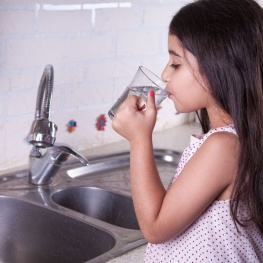PFAS in Drinking Water

Our Local Water Supply is Tested for PFAS
City of Madison
Madison Water Utility began voluntarily testing for PFAS years ago and tests two times a year. You can look up the water quality at your address, including PFAS, on Madison Water Utility’s website. If you want to learn more about what Madison Water Utility is doing about PFAS, visit their PFAS webpage.
Other Dane County Municipalities
Don’t live in Madison? Other communities in Dane County have tested their water through the DNR. Visit the DNR website and click “PFAS Sampling Info” under “Layer Controls.” Click on the circle next to the name of the municipality to find out the results. Contact your municipality if you want more information.
Water from Private Wells
If you’re in an area near PFAS contamination, it’s recommended that you test your well for PFAS. We offer free private well testing for PFAS for income-eligible households in Dane County, living outside the City of Madison (households in City of Madison are not eligible). Free testing is available while funding lasts, or through June 2024. We use guidelines under the US Department of Housing and Urban Development's Community Development Block Program to determine income eligibility. You can print an application form and follow instructions for returning it to us. Once your application has been approved, someone will contact you to schedule an appointment.
| Number in household | 1 | 2 | 3 | 4 | 5 | 6 | 7 | 8 |
|---|---|---|---|---|---|---|---|---|
| Annual Income (from 2022 tax return) | $66,300 | $75,750 | $85,200 | $94,650 | $102,250 | $109,800 | $117,400 | $124,950 |
Households who exceed the income limit, or are in the City of Madison are able to order sampling kits at the normal cost of $418. You can order a sampling kit by emailing us at lab@publichealthmdc.com. If you need help understanding your test results, please contact us at lab@publichealthmdc.com, even if you didn't get your well tested through us.
In Dane County, the Wisconsin State Lab of Hygiene is also able to test for PFAS. If you get your well tested, you can use this tool from the Department of Health Services to compare your test results to State standards. If PFAS levels are high, you can take steps to limit your exposure.
Reduce Your Exposure to PFAS in the Water you Drink
Tap Water
If you’re concerned about PFAS in your drinking water, there are steps you can take to reduce your exposure. Use a granular activated carbon or reverse osmosis filter, or get your water from a treatment system that uses one. Look for systems certified by ANSI/NSF Standards 53 or 58. This website has a list. Use them to filter your water used for:
- Drinking
- Cooking
- Making baby formula or food
- Washing fruits/veggies
- Brushing teeth
- Feeding pets
Bottled Water
The Food and Drug Administration hasn’t set limits on PFAS in bottled water. Brands who belong to the International Bottled Water Association test their water for PFAS each year. Look for bottled water labeled with the NSF or IBWA seal. If the label says “purified,” it’s probably filtered through reverse osmosis. This could mean it has less PFAS in the water.
PFAS Standards for Drinking Water
Current federal drinking water standards are 70 parts per trillion for two PFAS chemicals, PFOA and PFOS, combined. The State of Wisconsin has adopted these standards. There are no current Federal standards for groundwater. Recognizing that the majority of drinking water in Wisconsin originates from groundwater, the Wisconsin Department of Natural Resources asked the Wisconsin Department of Health Services (DHS) to create a groundwater standard for Wisconsin. DHS has made their recommendations, and the DNR is now working through the rule making process.
Notice that the groundwater recommendations for PFOA and PFOS are stricter than the current drinking water standards. The Federal drinking water standards were proposed in 2016. The Wisconsin groundwater recommendations were given in 2022. The US EPA is expected to finalize new drinking water standards at the beginning of 2024.
Drinking Water Standards
Federal | WI | ||
|---|---|---|---|
| PFOA | 70 | PFOA | 70 |
| PFOS | 70 | PFOS | 70 |
WI Surface Water Standards | |||
| PFOS | 8 | PFOA | 20 or 95* |
WI Groundwater Recommendations | |||
| PFOS | 20** | PFOA | 20** |
| FOSA | 20** | NEtFOSA | 20** |
| NEtFOSA | 20** | NetFOSE | 20** |
| PFNA | 30 | PFHxS | 40 |
| HFPO-DA | 300 | PFDA | 300 |
| PFDoA | 500 | DONA | 3000 |
| PFUnA | 3000 | PFBA | 10000 |
| PFTeA | 10000 | pfhXa | 150000 |
| PFODA | 400000 | PFBS | 450000 |
Standards are enforceable. Groundwater recommendations are currently undergoing review for standardization.
* If the water is intended for public water use, then the lower standard applies.
** combined total of 20 ppt


